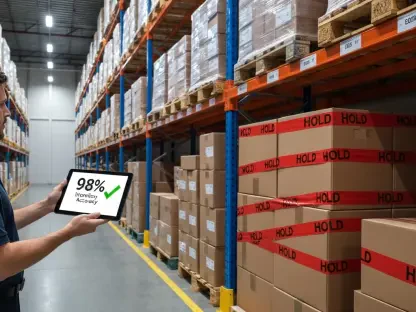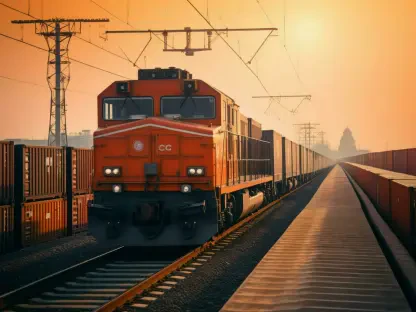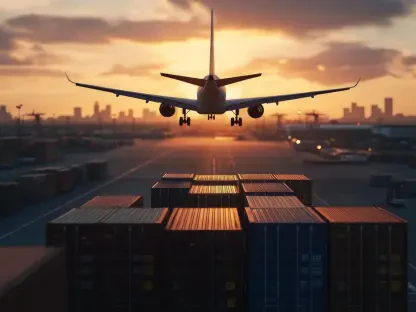In recent years, the stability of global shipping has faced unprecedented challenges, prompting businesses to seek alternative transport methods. The COVID-19 pandemic, coupled with geopolitical tensions, has severely disrupted sea transport, causing significant delays and increased costs. As a result, railways have become a more favored option for enterprises, offering greater reliability and efficiency to maintain supply chains. This shift in logistics strategies highlights a broader transformation in the industry, as companies adapt to new realities and seek more robust solutions to mitigate risks.
The Impact of COVID-19 on Sea Transport
The COVID-19 pandemic has caused massive disruptions in sea transport, dramatically affecting global supply chains in profound ways. Lockdowns and restrictive measures led to labor shortages, which in turn resulted in significant delays at ports worldwide. These logistical bottlenecks created a scarcity of shipping equipment, driving costs up and extending transit times. Ports faced unprecedented congestion, leaving ships anchored offshore for days, sometimes weeks, waiting for a berth. This situation not only delayed the movement of goods but also hampered the efficiency of the entire global supply chain.The ripple effects were felt across various industries, highlighting the fragility of relying heavily on maritime shipping routes. Businesses that once depended on predictable sea routes found themselves grappling with uncertainty and delays, prompting a reevaluation of their logistics strategies. Companies began to reassess their transportation methods, considering more reliable options to mitigate future disruptions. This reevaluation led many to explore alternative transport methods, particularly railways, which offered a potential solution to the challenges posed by the pandemic.
The Suez Canal Blockage: A Wake-Up Call
The 2021 blockage of the Suez Canal by the vessel Ever Given further emphasized the vulnerability of global shipping routes. This critical waterway, connecting the Mediterranean Sea to the Red Sea, is one of the most heavily trafficked maritime paths. The incident caused a massive backlog of ships, delaying countless shipments and putting additional strain on an already stressed supply chain. For several days, the world watched as efforts to free the ship were underway, underscoring the interconnectedness and susceptibility of global trade to such disruptions.The blockage served as a stark reminder of the risks associated with overreliance on single transit routes. Businesses that had already been pushed to their limits by the pandemic now faced another significant disruption. As a result, the incident pushed many to look for alternative pathways to ensure continuity and resilience in their logistics networks. Rail transport emerged as a promising solution, offering a viable alternative unaffected by such bottlenecks. The ability to bypass maritime chokepoints became a critical factor in the decision-making process for many companies seeking to safeguard their supply chains.
Geopolitical Tensions and Maritime Instability
In addition to the pandemic and the Suez Canal blockage, geopolitical tensions have created further instability in maritime transport. Conflicts in regions like the Red Sea and the Suez Canal zone have led to increased risks for merchant ships, impacting insurance premiums and necessitating detours. The ongoing conflict between Israel and Palestine, as well as Houthi attacks on ships from Yemen, exemplify the dangers facing sea transport. These factors have driven up costs and added layers of unpredictability, making businesses wary of relying solely on maritime routes.The ripple effects of these geopolitical tensions are felt throughout the global supply chain. Companies must navigate a complex landscape of risks, from the threat of direct attacks to the financial implications of higher insurance premiums and longer transit times. The combination of these elements has pushed businesses to seek safer and more reliable alternatives to ensure the stability of their logistical operations. Railways, with their ability to navigate less contentious routes, have gained prominence as a viable option in this context. The growing importance of rail transport reflects a broader trend toward diversification and risk management in global logistics.
The Emergence of Railways as a Viable Alternative
Rail transport has emerged as a reliable alternative, particularly for routes between Asia and Europe. Offering transit times of up to 20 days compared to the 60-70 days typical for sea transport, railways provide a significant advantage in terms of speed. This efficiency has become increasingly crucial for businesses aiming to ensure timely deliveries. The capacity to move goods quickly and reliably is a key factor in the decision-making process for many enterprises, especially in a climate where delays can have substantial financial repercussions.The logistical landscape has seen a notable shift, with many enterprises opting for rail transport to avoid the unpredictable nature of sea shipping. The reliability of railways, coupled with shorter transit times, has positioned them as a preferred choice for many industries. Companies are not only looking at railways for their speed but also for their consistency, which has become a critical factor in maintaining competitive advantages. By incorporating rail transport into their logistics strategies, businesses can achieve a level of assurance that has been lacking in maritime transport during these turbulent times.
Adaptations in Peak Season Strategies
Companies have also adjusted their peak season strategies in response to past disruptions. Many European businesses now begin their peak season preparations as early as May, rather than later in the year. This early stocking strategy aims to mitigate the risk of delays and ensure sufficient inventory for critical periods, such as the Christmas holidays. The shift in timing reflects a broader trend of proactive planning and risk mitigation in the logistics sector.These adaptations signify a broader trend of proactive planning and risk mitigation in the logistics sector. By advancing their preparations, businesses can better navigate the challenges posed by global crises, ensuring a more resilient supply chain. The move to earlier peak season preparations is a testament to the adaptability of enterprises and their willingness to invest in strategies that prioritize reliability over short-term cost savings. This shift toward proactive planning underscores the importance of anticipating potential disruptions and taking steps to mitigate their impact on the supply chain.
The Financial Impact: Rising Transportation Costs
The ongoing crises have also led to increased transportation costs, further complicating logistics planning. Shipping lines have imposed additional charges, including Peak Season Surcharges (PSS) and General Rate Increases (GRI). These cost inflations reflect the financial pressures on industry stakeholders. The economic impact of these disruptions is felt across the supply chain, from manufacturers to retailers, highlighting the need for more stable and predictable logistics solutions.Market analysts predict that bid prices for 40-foot containers could reach record highs, exacerbating the cost challenges for businesses. The industry’s leading Shanghai Containerized Freight Index (SCFI) has recorded its highest levels since August 2022, underscoring the economic impact of the disruptions in sea transport. As transportation costs continue to rise, companies are increasingly seeking alternatives that offer more predictable expense structures. Rail transport, with its relatively stable pricing and fewer unexpected surcharges, is becoming a more attractive option for businesses looking to manage costs effectively.
Prioritizing Supply Chain Reliability
In light of these challenges, companies are increasingly prioritizing reliability over cost. The memory of past disruptions has underscored the importance of stable, predictable transportation methods. This shift in focus is evident in the growth of long-term pricing agreements, although many of these agreements have been renegotiated at higher rates. The emphasis on reliability reflects a strategic pivot toward ensuring that supply chains can withstand future shocks.By emphasizing reliability, businesses aim to mitigate the risks associated with global crises and maintain more stable supply chains. The trend toward railway transport reflects this strategic pivot, highlighting the growing importance of dependable logistics solutions. As companies continue to adapt to the uncertainties of the global market, the focus on reliability and resilience will likely become even more pronounced. The ongoing shift toward rail transport is a clear indication of this evolving mindset, as businesses seek to build supply chains that are not only cost-effective but also robust enough to weather future disruptions.









